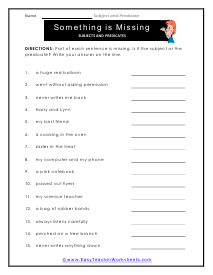Sentences are divided into two parts: the subject, which is who or what the sentence is about, and the predicate, which is everything else (verbs, adjectives, prepositional phrases, etc.). When break down a sentence the subject is what (in other cases whom) the sentence is concentrated on. The predicate is what that is doing or is. This tells us that the predicate is verb or modifier of the sentence. The subject, on the other hand, is noun or pronoun that appears within the sentence. A good way to identify the subject is to ask yourself "who" or "what" is the sentence about. To identify the predicate just look for an action that is taking place in the sentence. This skill will help us write clean and coherent sentences that our audience will grasp easily. A sentence is not a complete thought if it lacks either of these parts. As we bolster our arsenal as a quality writer will learn to master the use of both of these components in our sentences.
This collection of activity sheets uses short sentences and word prompts to help your students learn about the differences between subjects and predicates. The big read buttons, below, will be a godsend on those days that you tired. Answer keys really help a teacher go about their day. Grading is one of the most mindless tasks in education. A really quick way to remember this is if it is about the "who" or "what" you are referring to the subject. If it i something telling about the subject (who or what) it is the predicate.































